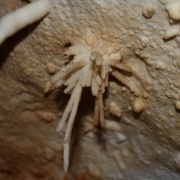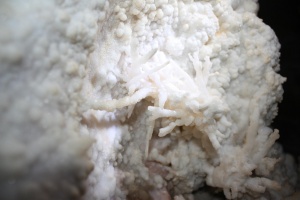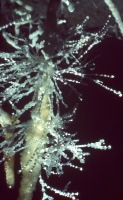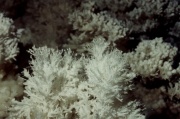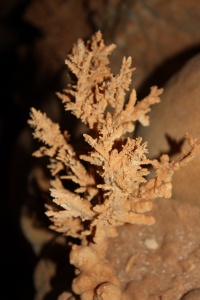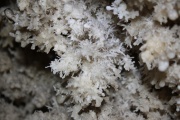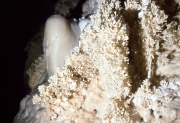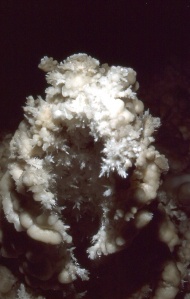Aragonite (Inventory)
From LagWiki
Contents |
Anthodite
Anthodites are clusters of quill-like sprays radiating from a central location.
Anthodites are usually white and resemble a sea urchin. Though in the aragonite section of the inventory form, they are usually composed of calcite but may have aragonite mixed in. Anthodites are hard to classify because they may resemble other speleothems such as antler helictites.
Antler helictites form by capillary or wicking of solutions through a tiny central canal. Anthodites form from thin solutions along the outer surface.
The differences between anthodites, frostwork and helictites, especially antler helictites, are transitional in nature. One may transform into the other and they are often found associated and even mixed together in the same formation. The differences are often subtle and distinctions are sometimes arbitrary. Deciding how to classify one of these types on the inventory form is sometimes subjective and inexact.
In general:
- Anthodites are spiky, like quills, and radiate from a central point.
- Frostwork is fine, needle-like and looks like ice crystals.
- Antler Helictites are more like a deer antler.
A single formation could show qualities of each and it would not be improper to classify it under more than one category, if so.
See also
References
- Hill, Carol; Paolo Forti (1997) Cave Minerals of the World (Second Edition ed.) National Speleological Society pp 45-47 ISBN: 1-879961-07-5
Anthodite, Aragonite
Aragonite Bush
The Aragonite bush field of the Aragonite section should record any observation of the bush form of aragonite.
Aragonite bushes are dense clusters of aragonite in the form of bushes or Christmas trees. They often exhibit frostwork, fine, white, needle-like growths of crystals that individually look very much like ice crystals. Aragonite bushes can vary in size from small to large. If the bush contains frostwork, that should also be recorded in the frostwork field.
See also
References
- Hill, Carol; Paolo Forti (1997) Cave Minerals of the World (Second Edition ed.) National Speleological Society pp 74-75 ISBN: 1-879961-07-5
- Palmer, Arthur N. (2007) Cave Geology CAVE BOOKS, Dayton, OH p 289 ISBN-13: 978-0-939748-66-2, ISBN-10: 0-939748-66-5
Aragonite Bush, Aragonite
Frostwork
The Frostwork field of the Aragonite section should record any observation of frostwork.
Frostwork is fine, white, needle-like growths of aragonite crystals that look very much like ice crystals. Frostwork can appear in aragonite bushes which should also be recorded in the aragonite bushes field. Frostwork can also appear separate from bushes on popcorn nodules or growing from calcite crusts and coatings.
Frostwork crystals are usually short but can be many millimeters long in some situations. They often radiate outward.
Examine all popcorn carefully for signs of frostwork growing within it and examine any aragonite bushes for frostwork which may be present at the tips.
See also
References
- Hill, Carol; Paolo Forti (1997) Cave Minerals of the World (Second Edition ed.) National Speleological Society pp 74-75 ISBN: 1-879961-07-5
- Palmer, Arthur N. (2007) Cave Geology CAVE BOOKS, Dayton, OH p 289 ISBN-13: 978-0-939748-66-2, ISBN-10: 0-939748-66-5
Rim
The Rim field of the Aragonite section should be used to record stations that exhibit rims of aragonite. Other mineral rims have their own field in their respective sections.
Aragonite rims (also sometimes known as vents) are wind formed features of aragonite. They form usually around constrictions where consistent airflow is present. They are smooth on the inside but rough on the outside with features such as popcorn or frostwork lining the outside surface. Rims form as a shell or projection extending on the upwind side of a constriction where moisture laden air consistently escapes. As such, they tend to require a pool or water source somewhere on the downwind side in order to provide the moist, warm air.
Rims can be any of a number of shapes from round tubes or eggs to more irregular shells or ears. They tend to conform somewhat to the shape of the constriction but may be biased in only one direction by the airflow. They can be found on the floor, walls or ceiling; anywhere air is or was escaping.
Rims can form from various mineral materials and several of them have fields on the inventory form. The appropriate field based on the mineral content of the rim feature should be used. Only gypsum rims are recorded in this field.
See also
Stalagmite
The Stalagmite field of the Aragonite section should list stations where stalagmites of aragonite are observed. Gypsum stalagmites and calcite stalagmites have their own fields on the form.
Aragonite Stalagmites are secondary floor deposits of aragonite and are similar to calcite stalagmites but are not smooth. They are covered with jagged aragonite nodules. These nodules are often brittle and easily broken if touched. It may be difficult to distinguish aragonite stalagmites from calcite coral stalagmites.
An aragonite stalagmite of any size or shape should be recorded in this field.
See also
Stalagmite, Aragonite
